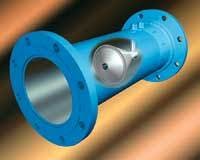Piping Change Nearly Leaves Engineer Up the River Without a Paddle
by Mike Dyer
• McCrometer V-Cone DP Flowmenter Solves Problem at Eastman Chemical Plant
A short straight pipe run between a river water pumping station and a valve at the Eastman Chemical Company’s plant in Kingsport, TN, caused critical water flow measurement accuracy problems for the company. The piping configuration left the company’s Utility Division engineer with only a straight pipe run of 15 feet, which was insufficient in length for accurate water flow measurement with the existing orifice plate flowmeter already in place.
To solve the flow measurement accuracy problem, Eastman staff contacted applications engineers at McCrometer and asked them to review the situation. They suggested that a differential pressure (DP) flowmeter, such as the company’s V-Cone, would be compatible with the 15-foot straight pipe run because of built-in flow conditioning inherent within its flowmeter’s design.
The Eastman personnel agreed with the application’s engineering assessment. They installed a 30-inch McCrometer V-Cone differential pressure flowmeter to support one of their large river water pumps. The flowmeter’s compatibility with shorter straight pipe runs not only provides excellent measurement accuracy, but also meant the Eastman personnel could avoid making more costly changes to their pump station and plant piping configuration.
“Our plant’s minimal straight pipe run of only about 15 feet between pump and valve required a flowmeter that offered extensive installation flexibility,” said Allen Clem, project engineer at Eastman Chemical. “The V-Cone, with its small-space installation ability, increased accuracy and large turndown ratio, enabled us to replace the orifice plate and gain immediate results. We are pleased so far with the flow indication. The V-Cone is performing well.”
The flowmeter accurately measures flow over a wide range of Reynolds numbers, the ratio of inertial to viscous forces in fluid mechanics, under all kinds of plant environmental conditions and in a variety of clean and dirty fluids. It operates on the same proven operation principle as other differential pressure type flowmeters, using the theory of conservation of energy in fluid flow through a pipe.
The unique design of this flowmeter, however, actually conditions fluid flow to provide a stable flow profile that increases measurement accuracy. The flowmeter’s design features a centrally located cone inside a tube (see Figure 1). The cone interacts with the fluid flow and reshapes the fluid’s velocity profile to create a region of lower pressure immediately downstream from itself.
The pressure difference, which is exhibited between the static line pressure and the low pressure created downstream of the cone, can be measured via two pressure sensing taps. One tap is placed slightly upstream of the cone and the other is located in the downstream face of the cone itself. The pressure difference can then be incorporated into a derivation of the Bernoulli equation to determine the fluid flow rate.
The cone’s central position in the line optimizes the velocity of the liquid flow at the point of measurement. It forms very short vortices as the flow passes the cone (see Figure 2). These short vortices create a low amplitude, high frequency signal for excellent signal stability. The result is a highly stable flow profile for measurement accuracy to ±0.5% with ±0.1% repeatability over a wide flow range of 10:1. All of this is accomplished with a minimal straight pipe run of only 0 to 3 diameters upstream and 0 to 1 diameters downstream from the cone.
In addition to excellent accuracy and repeatability over a broad range, this flowmeter is suitable for a broad range of applications in line sizes from 0.5" to 120" or larger. From large plant water pipelines, such as those at Eastman Chemical, to small process lines for ingredients or chemical injection, it’s a highly flexible flow measurement solution.
The contour shape of the cone also directs the flow without impacting it against an abrupt surface (see Figure 3). As a result, the beta edge of the cone isn’t subject to wear by dirty fluids. Because it remains unchanged, the flowmeter rarely, if ever, requires recalibration. Its no-moving parts design requires little maintenance and ensures a long life. These same characteristics make it suitable for high pressure, high temperature and corrosive environment applications as well.
Conclusion
As demand for and the cost of water increase, the need for accurate liquid flow measurement is more important than ever for plant engineers everywhere. Whether in retrofit applications such as at Eastman Chemical in Tennessee, or in plant expansions or new plants, the V-Cone differential pressure flowmeter is ideal when performance, accuracy and low cost-of-ownership are important instrumentation criteria. It gives process engineers a simple, relatively low-cost solution to obtaining accurate flow measurement.
About the Author: Mike Dyer is an applications engineer with McCrometer, a subsidiary of Danaher based in Hemet, CA. Contact: 951-652-6811 or www.mccrometer.com



